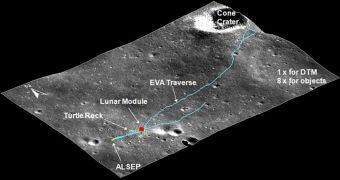The NASA Lunar Reconnaissance Orbiter (LRO) is undoubtedly one of the American space agency's most valuable assets in space today. In addition to being able to produce accurate maps of the Moon, and investigate possible landing sites for future missions, the probe can also apparently help create 3D images of particular structures, by using the LROC instrument. One such target was the Apollo 14 landing site, which had all of its equipment analyzed by the spacecraft. The data sets were combined in a series of 3D images, which reveal the size and shape of everything that was left behind.
In order to collect the images necessary for the 3D renditions, the LRO had to be positioned in slightly different orbits, while snapping photos of the same target area. The NAC cameras on LROC were put to good use, and the level of detail they provided was amazing. The structures that can be identified at the landing site include the ALSEP (Apollo Lunar Surface Experiments Package), and the descent stage of the Antares lunar module the mission used. A formation called “Turtle Rock” is also evidenced in the photos, alongside the footpaths the astronauts left behind while moving around.
One of the amazing features of LROC is its ability to measure small objects from high above, with remarkable accuracy. For example, in a close-up image it took of the lunar descent module, it was revealed that the equipment was about 3.0 meters (about 9.8 feet) tall, whereas the available specifications for the instrument show that it is, actually, 3.2 meters (about 10.5 feet) tall. Therefore, the cameras were off by just 20 centimeters, which is a remarkable feat. The same margin of error was recorded when establishing the diameter of the module. Measurements from the LRO showed it to be 4.4 meters (about 14.4 feet) wide, whereas specification data show the module is 4.2 meters (13.7 feet) wide.
All of these pieces of information were extracted using complex image-processing techniques, as well as reference points imprinted on the image. The 3D models were created by superimposing the model images of the equipment on the elevation map of the landing site, which was created using data from the LRO as well. Engineers managing the orbiter hope that these measurement capabilities will come in handy during other investigations too, such as other Apollo landing sites, or maybe peculiar landscape features in various regions of the Earth's natural satellite, Space Fellowship reports.

 14 DAY TRIAL //
14 DAY TRIAL //